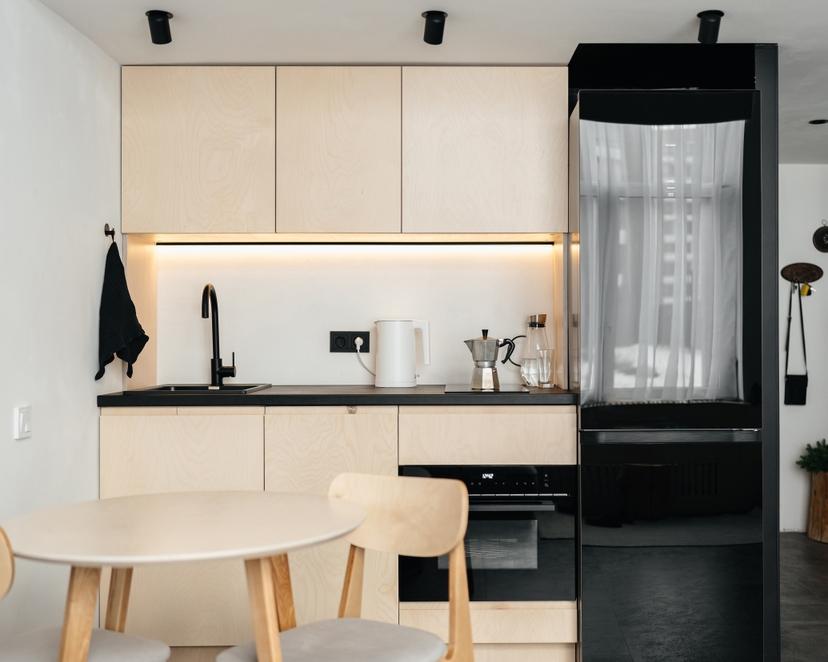
Kitchen plywood: which plywood is best for modular kitchen

March 20, 2024
Designing a modern and functional kitchen involves careful consideration of materials, and when it comes to cabinets and other elements, plywood is often the material of choice. Let’s explore the world of kitchen plywood, focusing on plywood kitchen design, the significance of plywood in crafting cabinets, and the critical question: which plywood is best for a modular kitchen?
Best Types of Plywood for Modular Kitchen
When choosing the best plywood as the material for a modular kitchen—especially the main part of kitchen furniture—we need to understand the different kitchen-grade plywood options:
Marine Plywood
Marine plywood is known for its ability to withstand water, which is essential for areas in the kitchen that are always wet, like where the sink cabinet is. Marine plywood is considered the best quality plywood to use in a kitchen.
BWP Plywood (Boiling Water Proof)
Boiling Waterproof Plywood is the most “highly recommended” for constructing a modular kitchen. It can withstand continuous contact with water and humidity, and is suitable for long usage in an Indian kitchen environment.
Fireproof Plywood
This plywood is extremely important for safety. The fire-retardant plywood is chemically treated so that it delays combustion. It’s a great choice for kitchen use when cooking with an open flame is the norm.
Calibrated Plywood
Calibrated plywood is produced with consistent thickness. It is perfect for laminating and/or veneering. The smooth finish of calibrated plywood makes it great for sleek cabinet designs.
MR Plywood (Moisture Resistant Grade)
MR grade kitchen ply is suitable for less humid areas of a kitchen. It is an economical choice and provides reasonable resistance to short exposure to water.
Plywood in Kitchen Design: An Overview
Plywood Kitchen Cabinets: A Modern Marvel
Plywood has become a staple in modern kitchen design, particularly for cabinets. Its popularity stems from a combination of strength, versatility, and aesthetic appeal. Unlike traditional particleboard or MDF, plywood offers enhanced durability, making it ideal for the demands of a busy kitchen.
The Rise of Plywood in Modular Kitchens
Modular kitchens, known for their sleek design and efficient use of space, often rely on plywood for construction. Plywood's structural integrity allows for modular components that are both durable and customizable, meeting diverse homeowner needs.
MR Plywood: Moisture Resistant Plywood
Moisture-resistant plywood, commonly known as MR plywood, is another suitable option for kitchen cabinets. While not as water-resistant as BWP plywood, MR plywood still offers good protection against moisture, making it a cost-effective choice for less wet areas.
Marine Plywood: Ultimate Water Resistance
For those seeking the utmost water resistance, marine plywood is an excellent choice. Originally designed for boat construction, its ability to withstand water makes it reliable for kitchen cabinets in high-humidity zones or areas requiring frequent cleaning.
Plywood Kitchen Design Tips
Aesthetics and Finishes
Plywood's natural wood grain is an aesthetic asset. To enhance this, consider veneers or laminates. Veneers showcase the natural beauty of the wood, while laminates offer a range of colors and textures, giving you design flexibility and easy maintenance.
Customization for Modular Efficiency
One of plywood's standout features is versatility. It can be cut to exact dimensions, making it ideal for modular kitchens. Whether designing cabinets, shelves, or pull-out drawers, plywood maximizes space and functionality.
Strength and Durability
Thanks to its cross-grain construction, plywood offers strength and stability. When used in kitchen cabinets, it withstands heavy loads and resists warping or cracking, ensuring long-lasting performance in a high-traffic environment.
Maintaining Plywood Kitchen Cabinets
Regular Cleaning Routine
Establish a routine using a mild soap and water solution to wipe down surfaces and remove grime or spills.
Avoid Harsh Chemicals
Avoid abrasive cleaners or harsh chemicals that can damage the finish. Stick to gentle cleaning agents to preserve the wood’s appearance.
Address Spills Promptly
Wipe away spills immediately and thoroughly dry the area to prevent moisture absorption and potential damage.
Factors to Consider Before Choosing Plywood for a Modular Kitchen
When it comes to kitchen-grade plywood, consider:
Waterproofing
Use factory-treated plywood for water exposure—BWP or marine grade for sink areas and countertops.
Thickness
16 mm (5/8") to 19 mm (3/4") is ideal for cabinets and shutters, offering durability.
Termite or Borer Resistance
Ensure the plywood is chemically treated against pests.
Finish Compatibility
Choose plywood compatible with your chosen laminates or veneers.
Weight Load Capacity
For heavy utensils or appliances, opt for high-density plywood.
Budget
MR plywood is budget-friendly; BWP and marine grades are premium but more long-lasting.
Why Choose Royale Touche Plywood for Modular Kitchen
When it comes to kitchen plywood, Royale Touche stands out:
High-Quality Raw Material
Uses top-grade hardwood veneers and adhesives for durable, consistent performance.
Moisture Resistant
Offers BWP and marine-grade options engineered for high moisture and water contact areas.
Termite and Borer Resistant
All kitchen plywood is chemically treated to prevent infestations.
Fire Resistant Options
Fire-retardant grades add an extra layer of safety for cooking areas.
Eco-Friendly and Sustainable
E1 and FSC certified with zero formaldehyde emissions—safe for your home.
Calibrated and Even Plane
Uniform thickness simplifies installation and ensures perfect alignment.
Warranty and Trust
Backed by warranties and a strong brand reputation for long-term quality.
Conclusion
In modern kitchen design, plywood remains a versatile and reliable material for modular cabinets. Choosing the right plywood—whether BWP, MR, or marine grade—depends on water resistance, aesthetics, and customization needs. Embrace plywood’s natural beauty and durability to create a stylish, functional culinary space.
